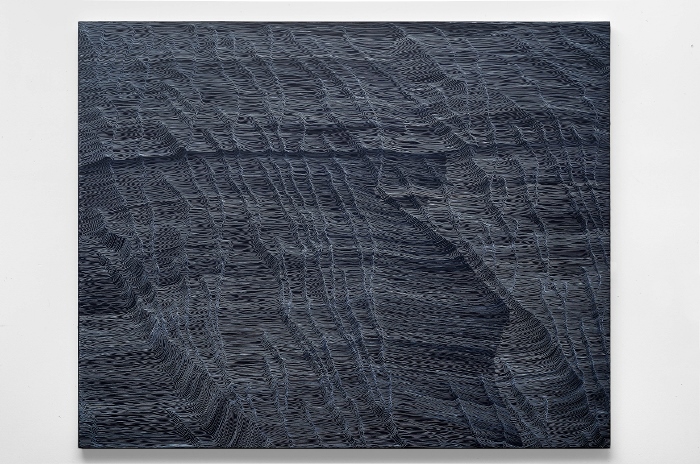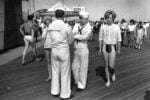Sean Gall – I paesaggi mentali e le linee di fuga

La serie dei Mindscapes, i Paesaggi Mentali di Sean Gall, qui presentati presso la sede romana dello Studio legale Ichino Brugnatelli a Palazzo Pichi, nascono, circa vent’anni fa
Comunicato stampa
L’occhio ha le sue strategie segrete. A volte ignote al pensiero cosciente. Irregolari, irrequiete. Chiede di perdersi, per poi ritrovarsi. Parte da un dettaglio per creare un mondo. La serie dei Mindscapes, i Paesaggi Mentali di Sean Gall, che qui presentiamo presso la sede romana dello Studio legale Ichino Brugnatelli a Palazzo Pichi, nascono, circa vent’anni fa, da una richiesta di suo fratello: un dipinto classico di paesaggio dell’Irlanda dell’Ovest, tra l’oceano Atlantico e le montagne selvagge, dove l’artista americano, che allora viveva sulla costa della California, si recava ogni anno in vacanza per visitare parte della sua famiglia. Ma succede che piova molto, in Irlanda. Sean si ritrovò bloccato per giorni nella fattoria della madre vicino Galway. Fuori ogni cosa era indistinta, tra nebbia e pioggia. In una stanza, un’immagine fotografica della campagna del Connemara catturò la sua attenzione. Non l’insieme, ma i dettagli. Il crepaccio di una montagna, un sentiero, le pietre a secco di una fattoria. L’occhio dell’artista restò impigliato. Quando il cielo si aprì al sereno splendente della migliore primavera del Connacht, Sean Gall cominciò a guardare in faccia, e a modo suo, il paese occidentale che aveva alimentato le leggende gaeliche e le poesie di William Butler Yeats: ne vennero fuori quadri-disegni che hanno poco a vedere con la classica pittura di paesaggio. Le linee tracciate con l’inchiostro, dagli incroci stretti, precisi, ossessivi fanno pensare a una mappa sulla quale germinano sogni. Come se un cartografo medievale maiorchino avesse realizzato un portolano con l’aiuto di Joan Mirò. Il dettaglio reale si perde nelle mappe-paesaggio di Gall, per poi riaffiorare. L’artista continuò a casa, dal 2004 a oggi, guardando la griglia di Los Angeles da Griffith Park – location celebre della storia del cinema per la sfida al coltello di James Dean in Gioventù Bruciata – mentre scende verso un altro oceano, il Pacifico. Qui finisce il mondo occidentale, come, nel Medioevo europeo, era il Connemara irlandese l’estremo limite dell’Occidente. Sono luoghi dove si arenano i sogni. E i fantasmi dell’immaginazione. I Mindscapes di Sean sono reti per afferrarli. L’artista cita tra le sue ispirazioni i disegni di Peter Saville degli anni ’80 del secolo passato. L’iperrealismo “inganna l’occhio” di Wayne Thiebaud con i saliscendi di San Francisco. I collages di Mark Bradford in cui Los Angeles si ritrae in uno specchio in fiamme e in frantumi. Le variazioni musicali di Brian Eno. Ma forse sono giunti nel suo inconscio, per “sentieri mentali”, per passaggi segreti, le scene urbane della Città degli Angeli degli anni ’30 e ’40 dell’artista italo-americano Leo Politi, che hanno un tocco fiabesco.
Ai paesaggi mentali si affiancano le linee immaginarie. I failed attempts at drawing a straight line, tentativi falliti nel disegnare linee rette, sono in realtà la prova che nel mondo reale, come in quello dell’arte, bisogna curvare le traiettorie, e il pensiero, per uscire dal labirinto. Qui le tecniche, stesura di colori acrilici in genere scuri, con inclusioni ed esplosioni improvvise di pigmenti, sono attraversati da linee sottili come capelli che rendono la superficie leggerissima, impalpabile, come una garza. Il linguaggio artistico si affaccia sull’informale. E caratteri strani, segni di energia infantile o resti di lingue perdute si sporgono su altri paesaggi - remoti, a tratti tempestosi. Fanno pensare a diagrammi, alle pulsazioni della mente, al brain imaging degli scanner di ultima generazione. Così come i Mindscapes dagli accenti fantastici richiamano le sinapsi cerebrali. Negli intrecci delle mappe mentali di Sean, come nella plasticità del nostro cervello, le connessioni continue, di continuo rinnovate, sono le porte che si aprono all’arte e alla realtà.
Fabio Sindici
Sean Gall è nato e cresciuto in California, tra San Jose e Los Angeles, USA. Ha conseguito un Master in Fine Arts al California Institute of the Arts (CalArts) di Valencia, nel 1999. Tra le sue mostre personali ci sono Atmospheres and Mindscapes alla Galleria Project 210 di Pasadena nel 2009 e Four Drawings by Sean Gall presso Unlikely Stories nel 2013. Ha anche esposto in diverse collettive, tra cui citiamo: Staff Show al LACMA (Los Angeles County Museum of Art), Los Angeles nel 2006 e nel 2008; Mastodon Maze da Mastodon Mesa, Los Angeles nel 2010; DotSandPlastic a Madrid, durante la fiera Arco nel 2019. Da anni vive e lavora a Roma, nel quartiere di Testaccio dove ama perdersi in lunghe camminate.
Fabio Sindici è nato a Roma, Italia. È giornalista, autore televisivo, critico d’arte e curatore. I suoi articoli sono apparsi su giornali e riviste nazionali come La Stampa, L’Espresso, La Repubblica, Il Foglio e su pubblicazioni specialistiche quali Artribune e Terzocchio. Ha scritto numerosi reportage e tiene una rubrica, Totem e tribù, sulla piattaforma online Substack. Si occupa di storie di crocevia, tra cultura e scienza, politica e costume. Alcuni suoi brevi saggi, poesie e lavori di fiction sono stati pubblicati all’interno di cataloghi e libri d’arte. Nel 2018 e nel 2019 ha tenuto come insegnante due masterclass all’Accademia di Belle Arti di Roma.
Lo Studio Ichino Brugnatelli, con la presente mostra nella sua sede di Roma si apre a iniziative di sostegno alle arti.
LAST OF THE WEST
MINDSCAPES AND LINES
Solo Show
By Sean Gall
Curated by
Fabio Sindici
Opening reception December 3rd, from 7 PM
On view till December 15th (by appointment)
Palazzo Pichi, Corso Vittorio Emanuele II, n. 154, Rome
The human eye elaborates its secret strategies. Random, restless plans; sometimes beyond one’s consciousness. It loves getting lost, just to find its way again. It can create worlds from a detail. Sean Gall’s Mindscapes series of works that are now on view in the Roman rooms of Studio Ichino-Brugnatelli at Palazzo Pichi, were born, around 20 years ago, from his brother’s request for a landscape painting of the famous rugged coastal country of West Ireland, between mountains and Ocean. What came out was an absolute atypical ink and acrylic series of drawings of a landscape that originates from the fabulous outside to get lost in the fantastic within. Every year, Sean visits his mother and step father who live in Connemara, the wildest part of Western Ireland, near the port of Galway. At the time of his brother’s request, the vacation started with the usual crazy Irish weather: rainy days in a row that forced him to remain at his mother’s farm. Outside rain and fog blurred any contour. Sean’s attention was drawn to a photograph of the Connemara landscape, hanging on the wall. It was not the whole that caught his eye; the details instead: a winding path, a section of a mountain, the cracked lines in a dry stone wall. When the sun dispersed the fog and the clouds, the painter went hunting for these lines in the country.
Out there was the western country that nourished the Gaelic myths and the poetry of William Butles Yeats. It nourished his “pictorial maps” that look at a world between the physical structures and the mind network in which they are reflected and transformed. A web of lines - details, meticulously, obsessively drawn. Fantastic forms germinate through the grid. It is like if a Middleage Mayorquin cartographer created a “portolano” map with the help of Joan Mirò. The artist keeps working at the Mindscapes in his home in Los Angeles, the following years. He draws with his pens and archival ink, listening to Brian Eno’s electronic sound homaging the Apollo Mission to the Moon. He looks at the fantastic biomorphic shape the City of Angels assumes when observed from atop one of its canyons or from a window of a landing airplane: grids and veins of light. He drew from Griffith Park, near his atelier. As Connemara coast is the last west of Europe, California is the edge of the western world today, facing the Pacific Ocean. Dreams were born and trapped. Hollywood made an industry of it. Gall’s mindscapes are a fishing net, where dreams are caught, but they are not dying. They flourish instead. The artist, who keeps working on the series in his studio in Rome, where he resides today, cites among his inspirations the drawings from the 80s by Peter Saville, a designer well known for his connections with the music industry. The Mark Bardford collages and the deceptive hyper-realistic views of San Francisco by Wayne Thiebaud had an influence too. As well, maybe by a secret unconscious passage entered in his imagination the illustrations of LA in the 30s and 40s by Leo Politi, with their touch of magic.
Together with the Mindscapes, Sean worked on another, connected series: Failed attempt at drawing a straight line, also in this show. It demonstrates that thoughts and drawings need a curve, a bump, a tremble, to get out of the labyrinth. Lines thin as hair run on paper or canvas, drawn by Gall with a paint pen on layers of acrylic paint: they are slightly rippled, a dark sea, a geo-radar investigating continental masses and the mind of the observer. There are pigmental inclusion and explosions, almost to free the painter’s instinct out of the grids and nets of the Mindscapes. The style here nods to the informal. The observer can guess a graphic energy trying to emerge on the surface, remote alphabets, mostly forgotten, a message from depths of the mind. They make one think of brain imaging as the Mindscapes remind one of brain synapses. There is a mysterious plasticity in Sean Gall’s art, always ready to connect and re-connect to open new views to the eye.
Fabio Sindici
Sean Gall was born and grew up in California, mostly in San Jose and Los Angeles, USA. He obtained a Master Degree in Fine Arts at California Institute of the Arts (CalArts) in Valencia in 1999. Among his solo shows we can cite Atmospheres and Mindscapes in 2009 at 210 Art Project in Pasadena and Four Drawings by Sean Gall in 2013 at Unlikely Stories. Gall has also exhibited extensively in
group shows in America and Europe, among those: Staff show in 2006 and 2008 at LACMA (Los Angeles County Museum of Art) in Los Angeles, Mastodon Mesa in 2010 at Mastodon Maze, Los Angeles, DotSandPlastic in 2019 in Madrid during Arco art fair. He lives and works in Rome, in Testaccio area, where he loves getting lost on long walks.
Fabio Sindici is journalist, tv author, art curator and critic based in Rome, Italy. His articles have been published in leading newspapers and magazines like La Stampa, L’Espresso, La Repubblica, Il Foglio. He also contributed to contemporary art publications such as Artribune and Terzocchio. On the online platform Substack he writes a column: Totem e Tribù. His writings mainly focuses on the crossroads of culture, science, politics and lifestyle. Some of his poems and short fiction stories have been included in art books and catalogs. He taught two masterclasses at Accademia di Belle Arti in Rome in 2018 and 2019.
Studio Ichino Brugnatelli, starting with the present exhibition, opens the doors of his Roman offices to substain Arts



